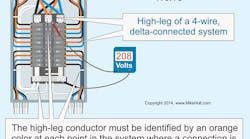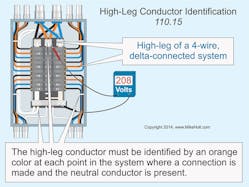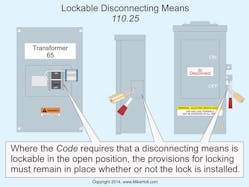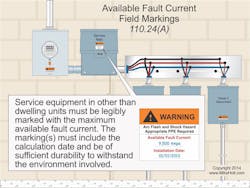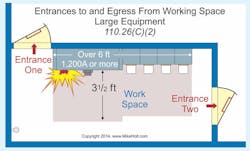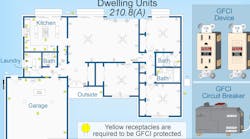Article 110 contains some of the most important but neglected parts of the Code. It also answers these basic questions:
• How should conductors be terminated?
• What kinds of warnings, markings, and identification does an installation require?
• How much working clearance is enough?
It also covers the general requirements for the examination and approval, installation and use, access to, and spaces about electrical equipment. In addition, it lists general requirements for enclosures intended for personnel entry (manholes, vaults, and tunnels).
Goes without saying
After the statement of scope, the next nine sections provide requirements that may seem like common sense. For example, it seems unnecessary for the Code to explicitly state your installation must be free from short circuits, but it does [110.7].
Make sure you understand the implications of the “common sense” requirements, rather than gloss over them. For example, actually complying with the “free from short circuits” requirement may require testing in the field.
Short circuit current
Available short circuit current is the current available at a given point in the electrical system. It’s different at each point — the highest at the electric utility transformer and lowest at branch circuit loads.
Electrical equipment must have a short circuit current rating that permits the circuit protective device to open from a short circuit or ground fault without extensive damage to the equipment [110.10]. To meet these requirements, use equipment listed for the application.
Execution
Under the heading “Mechanical Execution of Work,” the Code requires installing equipment in a neat and workmanlike manner [110.12]. EC&M’s “Code Violations” department often shows installations so sloppy that “execution” seems an appropriate penalty for the installer. But your work doesn’t have to be that bad to violate the intent of this section.
How can you understand and apply accepted industry practices when 110.12 provides only a few details on what’s expected? A good resource is ANSI/NECA 1, “Standard Practices for Good Workmanship in Electrical Construction.”
Electrical equipment must be firmly secured to the surface on which it’s mounted [110.13]. This is obviously part of workmanlike execution, but the Code provides this and other mounting requirements separately from 110.12 (see 314.23 for similar requirements for boxes]. It also does that with requirements for conductor terminal and splicing devices [110.14], providing nearly a whole page of requirements.
High-leg
On a 4-wire, delta-connected, 3-phase system, where the midpoint of one phase winding of the secondary is grounded, you have a high-leg system. The conductor with 208V to ground must be durably and permanently marked by an outer finish orange in color (or other effective means) [110.15]. Place this identification at each connection point where the neutral conductor is present [230.56] (Fig. 1).
The Code provides other important rules relating to the high leg. For example, consider panelboards. Units supplied by a 4-wire, delta-connected, 3-phase system must have the high-leg conductor terminate to the “B” phase of a panelboard [408.3(E)].
Arc flash hazard warning
Previous versions of the Code required manufacturer-applied arc-flash warnings on certain equipment [110.21(A)]. New with the 2014 Code is an additional requirement for field-applied warnings [110.21(B)]. Where caution, warning, or danger signs or labels are required, the labels must meet the following:
1) The markings must use words, colors, or symbols that effectively warn personnel. Note: ANSI Z535.4, “Product Safety Signs and Labels,” provides guidelines for the design and durability of signs and labels.
2) The label can’t be handwritten and must be permanently affixed to the equipment. Exception: Labels that
contain information that’s likely to change can be handwritten, if legible.
3) The marking must be of sufficient durability to withstand the environment involved.
Mark disconnects
Each disconnecting means must be legibly marked to indicate its purpose unless located and arranged so the purpose is evident [110.22]. The marking must be of sufficient durability to withstand the environment, as shown in Fig. 2.
Where the Code requires that a disconnecting means is lockable in the open position, the provisions for locking must remain in place whether the lock is installed or not [110.25] (Fig. 3).
Exception: Locking provisions for cord- and plug-connected equipment don’t need to remain in place without the lock installed.
Tested series-rated installations must be legibly field-marked per 240.86(B) and 110.21(B) to indicate the equipment has been applied with a series combination rating.
Available fault current
Service equipment in other than dwelling units must be legibly field-marked with the maximum available fault current (including the date the fault current calculation was performed) and be of sufficient durability to withstand the environment 110.24(A), as shown in Fig. 4.
If modifications might affect the available fault current at the service, recalculate and remark [110.24(B)].
The markings required here are for compliance with 110.9 and 110.10. They’re not for arc flash analysis. Arc flash hazard information is available in NFPA 70E, “Standard for Electrical Safety in the Workplace.”
Part II and beyond
The preceding requirements apply to all electrical installations. Part II of Art. 110 provides more requirements, but only for systems 600V or less. Part III provides more requirements, but only for systems greater than 600V. Part V covers tunnel installations over 600V. Part V covers manholes. Going forward, we’ll look only at Part II.
Space: A constant frontier
Due to widespread misunderstanding, meeting the equipment space requirements is a constant struggle at many facilities. One commonly overlooked fact is that the NEC rules on space aren’t recommendations. They are federal law. OSHA uses the NEC text and tables almost verbatim. Violations can result in far more than a warning from the AHJ.
A commonly accepted myth is that if you have exactly 3 ft of space in front of a panel (after moving boxes and crates away), the installation is legal. The Code has many other space requirements, and an installation could be deficient even with 4 ft of space in front of a panel. In addition, those boxes and crates aren’t permitted; OSHA regulations plainly state these spaces “shall not be used for storage” [29 CFR 1926.403(i)(1)(ii)].
Equipment that people might need to work on must have access and must have adequate working space around it [110.26]. The NEC provides minimum distances in Table 110.26(A)(1).
For most installations, you can use these figures and have no issue with the AHJ or the OSHA inspector. But examine the installation for complicating factors that call for exceeding these distances. For example, the width of the equipment may be reason to go beyond the table value [110.26(A)(2)].
If facility management resists increasing these limits, refer them to 29 CFR 1926.403 (OSHA’s electrical space requirements).
As you go about figuring out how much space needs to be where, account for such things as the fact that working space isn’t required for the back or sides of assemblies where all connections and all renewable or adjustable parts are accessible from the front [110.26(A)(1)(a)], as shown in Fig. 5. The Code doesn’t mandate excess space; it mandates adequate space for doing the work.
Entrance and egress requirements also apply. For example, you must have an entrance to and egress from each end of the working space of electrical equipment rated 1,200A (or more) that’s more than 6 ft wide. The opening must be at least 24 in. wide and 6½ ft high [110.26(C)(2)], as shown in Fig. 6.
Note also that switchboards, panelboards, and motor control centers must have dedicated equipment space [110.26(E)]. Different rules apply to indoor installations versus outdoor ones.
Let there be light
Service equipment, switchboards, panelboards, and motor control centers located indoors must have illumination. And it can’t be controlled by automatic means only [110.026(D)]. The NEC doesn’t specify how much light is adequate, so apply common sense. If in doubt, err on the side of too much light.
Guarding
Live parts of electrical equipment operating at 50V or more must be guarded against accidental contact [110.27(A)], which can be done by:
1) Locating them in a separate room, vault, or enclosure.
2) Guarding them with a partition or screen.
3) Locating them on a balcony or platform.
4) Elevating them above the floor or working surface (8 ft for 50V through 300V, 8½ ft for 301V through 600V).
Entrances to rooms and other guarded locations containing exposed live parts must be marked with conspicuous signs forbidding unqualified persons from entering.
Keeping in compliance
The rules in Art. 110 aren’t hard to understand or implement. So why are Code violations so common, and what can you do about this problem? Many violations arise due to misunderstanding, as with space issues. Many arise due to inattention to the rules, such as when a control panel is modified over the years, but proper markings and good workmanship are neglected.
To solve these problems, update your construction and maintenance documentation to specifically include and reference Art. 110 requirements. Then create test procedures and inspection checklists for confirming compliance when the work is done.
Holt is the owner of Mike Holt Enterprises, Inc. in Leesburg, Fla. He can be reached at www.mikeholt.com.
